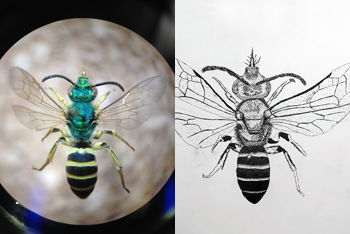Cynthia Eaton
“Ewww! Bugs? Seriously?” “Are we going to have to, um, touch these things?” The reactions that Meredith Starr received from her Drawing I students when she announced her collaboration with Eastern campus entomologist Joe Napolitano weren’t exactly encouraging. Art students, she noted to the packed audience for the third conversation in the FA New Member Discussion Series on February 20, don’t usually expect that they’ll be drawing bugs. Yet draw bugs they did. And they loved it. Starr and Napolitano developed the idea for this collaboration after a conversation about how observation is a fundamental connection between art and science. Napolitano invited Starr to bring her Drawing I students to come to his lab, look at the insects his students were studying and to draw what they saw.
“It was amazing,” Starr told the audience, “to watch the students shift so quickly—from the moment they looked through the microscopes—from resistant to enthusiastic to even passionate about the opportunity to draw these insects. They immediately pulled out their mobile phones, for example, and started trying to take pictures through the microscope lens.” The drawings speak for themselves. Starr also noted that when they returned to their classroom, several students commented on Professor Napolitano’s personality. “What other classes does he teach?” they asked. “I really want to take a class with him!” This impressed Starr, since art students don’t often express such eagerness to enroll in science courses. Napolitano introduced the next collaboration for the panel discussion. He talks with his students about how scientists get their information from peer-reviewed scientific journals, but that’s not how the public consumes scientific information. Thus, Napolitano collaborated with Susan Wood, Eastern campus librarian, so she could teach his students how to find quality research on course-related topics.
Wood met with Napolitano’s students for three hours, so she could help them understand scientific research and the publication cycle. In addition to the literature review required for the course, Wood’s larger goal was to improve students’ scientific literacy and understand how and why scientific information gets into various media. The third collaboration on the panel was introduced by librarian and The WORD staff writer Sue DeMasi. With “a desire to promote discussion on issues of social justice, bigotry and tolerance on campus,” DeMasi said, she collaborated with colleagues on several performance pieces. During a recent sabbatical, DeMasi wrote a play called Mosiac relying on oral histories of the Great Depression. For Mosiac, she noted, “students had to do a little bit of research in the library. That was the best part because as librarians we don’t get to know students as well as faculty because they rush in, get what they need and leave.” Between providing research assistance and working on the production of the three plays, DeMasi found the interactions with students and colleagues invigorating. All three faculty-student efforts were performed for the Grant campus community in the Shea Theater.
Alyssa Kauffman spoke of her role in collaborating with DeMasi and others for Mosaic as well as The Laramie Project and The Vagina Monologues. Kauffman got her Small Group Communication class to do a cold reading of Mosaic and she helped other students of hers get involved The Laramie Project and The Vagina Monologues. She noted, “Laramie was interesting because most of my students were small children in 1998 when Matthew Shepard was murdered.” This also led students to do research in the library with DeMasi, Bruce Seger and other librarians so it was an effective way to teach them history as well as to open up conversations about gender bias. These cross-discipline conversations—whether finding beauty in bugs when bringing art and science students together or getting communications students actively bringing their library research to the theater—are precisely the type of collaborations that the FA has been celebrating in the New Member Discussion Series. |

